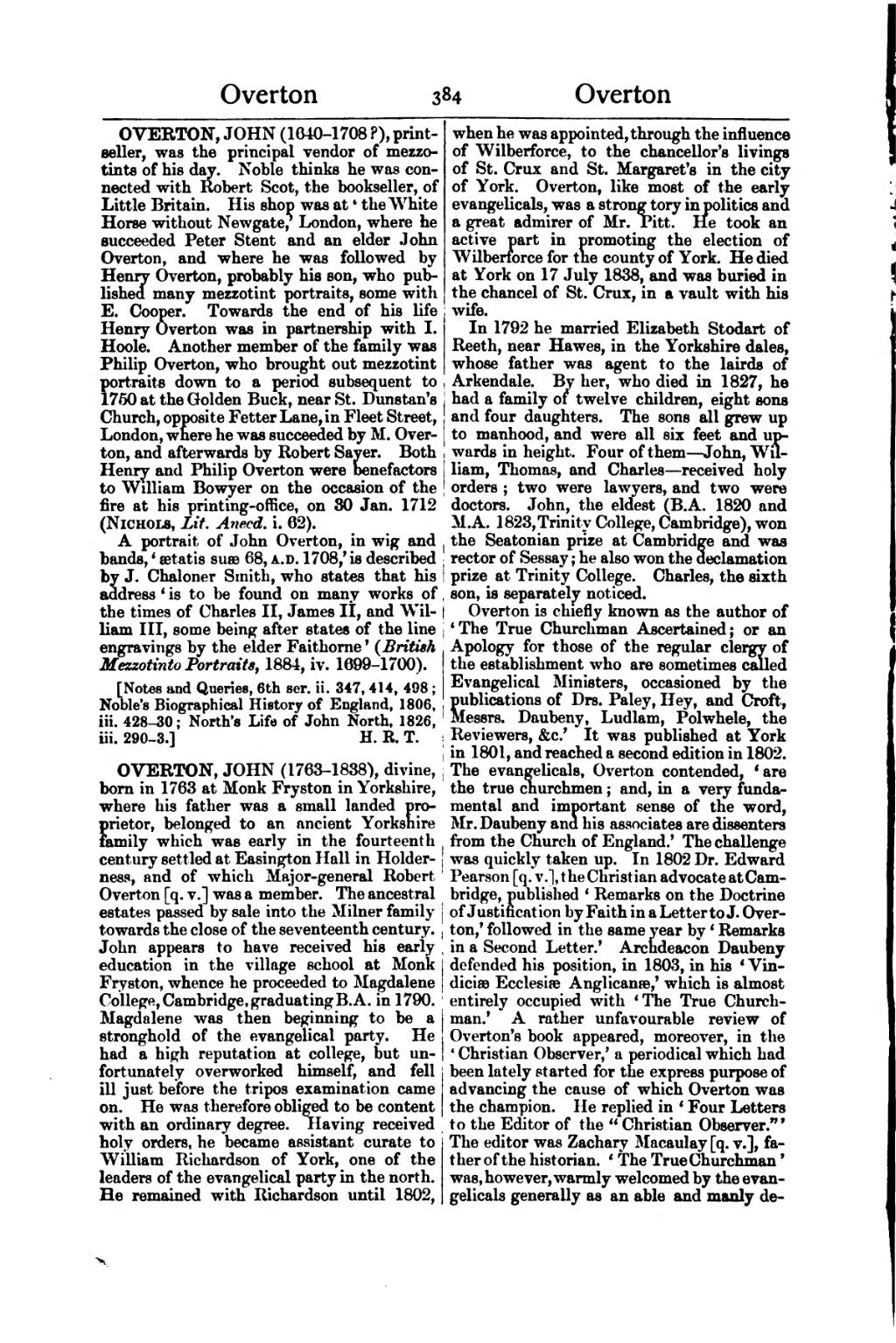OVERTON, JOHN (1640–1708?), printseller, was the principal vendor of mezzotints of his day. Noble thinks he was connected with Robert Scot, the bookseller, of Little Britain. His shop was at ‘the White Horse without Newgate,’ London, where he succeeded Peter Stent and an elder John Overton, and where he was followed by Henry Overton, probably his son, who published many mezzotint portraits, some with E. Cooper. Towards the end of his life Henry Overton was in partnership with I. Hoole. Another member of the family was Philip Overton, who brought out mezzotint portraits down to a period subsequent to 1750 at the Golden Buck, near St. Dunstan's Church, opposite Fetter Lane, in Fleet Street, London, where he was succeeded by M. Overton, and afterwards by Robert Sayer. Both Henry and Philip Overton were benefactors to William Bowyer on the occasion of the fire at his printing-office, on 30 Jan. 1712 (Nichols, Lit. Anecd. i. 62).
A portrait of John Overton, in wig and bands, ‘ætatis suæ 68, A.D. 1708,’ is described by J. Chaloner Smith, who states that his address ‘is to be found on many works of the times of Charles II, James II, and William III, some being after states of the line engravings by the elder Faithorne’ (British Mezzotinto Portraits, 1884, iv. 1699–1700).
[Notes and Queries, 6th ser. ii. 347, 414, 498; Noble's Biographical History of England, 1806, iii. 428–30; Gay's Trivia, ii. 488–9; North's Life of John North, 1826, iii. 290–3.]
OVERTON, JOHN (1763–1838), divine, born in 1763 at Monk Fryston in Yorkshire, where his father was a small landed proprietor, belonged to an ancient Yorkshire family which was early in the fourteenth century settled at Easington Hall in Holderness, and of which Major-general Robert Overton [q. v.] was a member. The ancestral estates passed by sale into the Milner family towards the close of the seventeenth century. John appears to have received his early education in the village school at Monk Fryston, whence he proceeded to Magdalene College, Cambridge, graduating B.A. in 1790. Magdalene was then beginning to be a stronghold of the evangelical party. He had a high reputation at college, but unfortunately overworked himself, and fell ill just before the tripos examination came on. He was therefore obliged to be content with an ordinary degree. Having received holy orders, he became assistant curate to William Richardson of York, one of the leaders of the evangelical party in the north. He remained with Richardson until 1802, when he was appointed, through the influence of Wilberforce, to the chancellor's livings of St. Crux and St. Margaret's in the city of York. Overton, like most of the early evangelicals, was a strong tory in politics and a great admirer of Mr. Pitt. He took an active part in promoting the election of Wilberforce for the county of York. He died at York on 17 July 1838, and was buried in the chancel of St. Crux, in a vault with his wife.
In 1792 he married Elizabeth Stodart of Reeth, near Hawes, in the Yorkshire dales, whose father was agent to the lairds of Arkendale. By her, who died in 1827, he had a family of twelve children, eight sons and four daughters. The sons all grew up to manhood, and were all six feet and upwards in height. Four of them—John, William, Thomas, and Charles—received holy orders; two were lawyers, and two were doctors. John, the eldest (B.A. 1820 and M.A. 1823, Trinity College, Cambridge), won the Seatonian prize at Cambridge and was rector of Sessay; he also won the declamation prize at Trinity College. Charles [q. v.], the sixth son, is separately noticed.
Overton is chiefly known as the author of ‘The True Churchman Ascertained; or an Apology for those of the regular clergy of the establishment who are sometimes called Evangelical Ministers, occasioned by the publications of Drs. Paley, Hey, and Croft, Messrs. Daubeny, Ludlam, Polwhele, the Reviewers, &c.’ It was published at York in 1801, and reached a second edition in 1802. The evangelicals, Overton contended, ‘are the true churchmen; and, in a very fundamental and important sense of the word, Mr. Daubeny and his associates are dissenters from the Church of England.’ The challenge was quickly taken up. In 1802 Dr. Edward Pearson [q. v.], the Christian advocate at Cambridge, published ‘Remarks on the Doctrine of Justification by Faith in a Letter to J. Overton,’ followed in the same year by ‘Remarks in a Second Letter.’ Archdeacon Daubeny defended his position, in 1803, in his ‘Vindiciæ Ecclesiæ Anglicanæ,’ which is almost entirely occupied with ‘The True Churchman.’ A rather unfavourable review of Overton's book appeared, moreover, in the ‘Christian Observer,’ a periodical which had been lately started for the express purpose of advancing the cause of which Overton was the champion. He replied in ‘Four Letters to the Editor of the “Christian Observer.”’ The editor was Zachary Macaulay [q. v.], father of the historian. ‘The True Churchman’ was, however, warmly welcomed by the evangelicals generally as an able and manly de-
